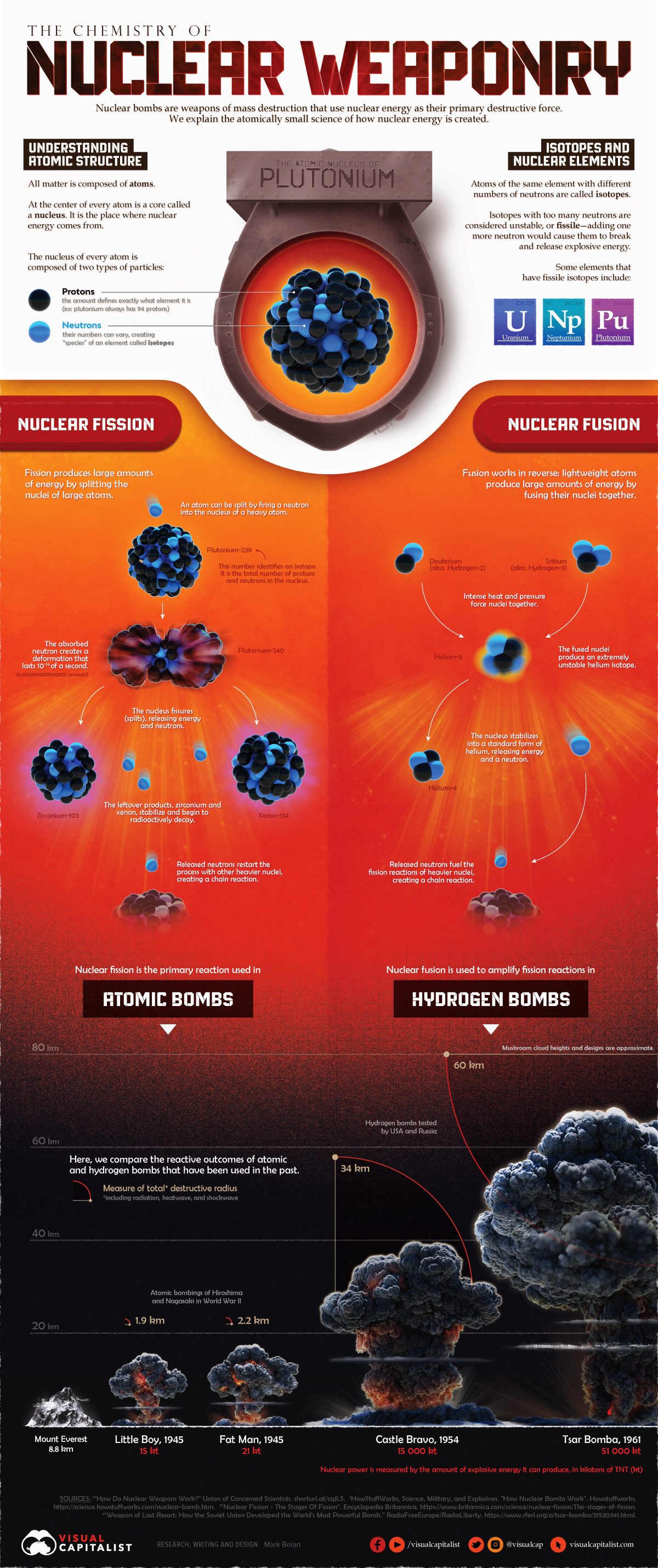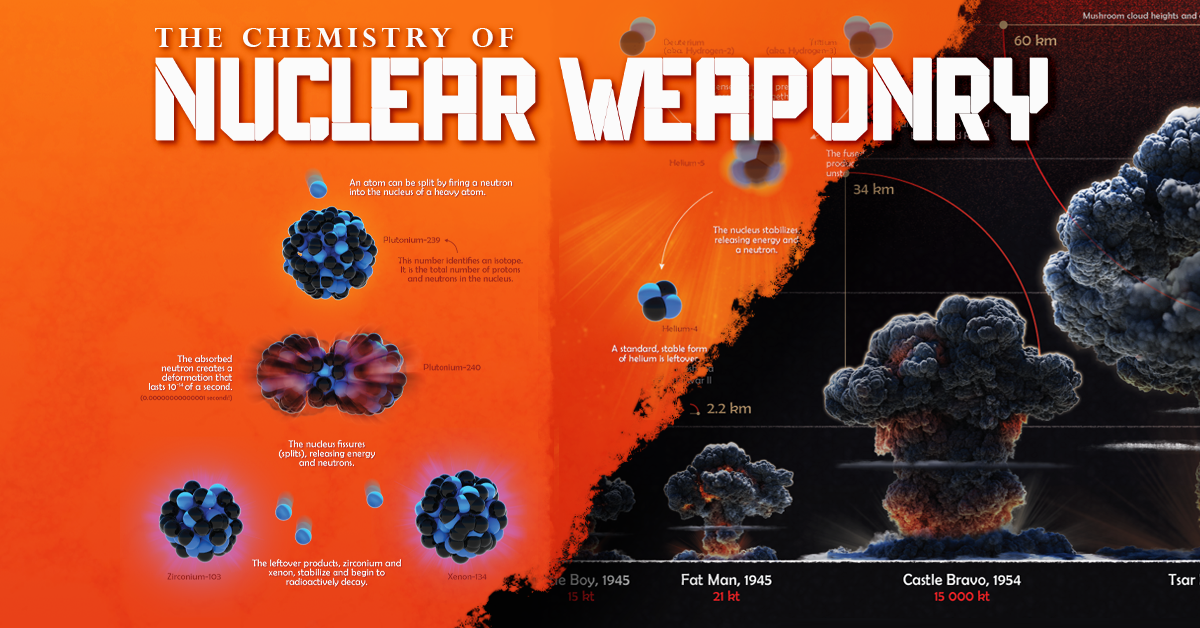Politics
The Science of Nuclear Weapons, Visualized

Visualized: How Nuclear Weapons Work
In 1945, the world’s first-ever nuclear weapon was detonated at the Trinity test site in New Mexico, United States, marking the beginning of the Atomic Age.
Since then, the global nuclear stockpile has multiplied, and when geopolitical tensions rise, the idea of a nuclear apocalypse understandably causes widespread concern.
But despite their catastrophically large effects, the science of how nuclear weapons work is atomically small.
The Atomic Science of Nuclear Weapons
All matter is composed of atoms, which host different combinations of three particles—protons, electrons, and neutrons. Nuclear weapons work by capitalizing on the interactions of protons and neutrons to create an explosive chain reaction.
At the center of every atom is a core called the nucleus, which is composed of closely-bound protons and neutrons. While the number of protons is unique to each element in the periodic table, the number of neutrons can vary. As a result, there are multiple “species” of some elements, known as isotopes.
For example, here are some isotopes of uranium:
- Uranium-238: 92 protons, 146 neutrons
- Uranium-235: 92 protons, 143 neutrons
- Uranium-234: 92 protons, 142 neutrons
These isotopes can be stable or unstable. Stable isotopes have a relatively static or unchanging number of neutrons. But when a chemical element has too many neutrons, it becomes unstable or fissile.
When fissile isotopes attempt to become stable, they shed excess neutrons and energy. This energy is where nuclear weapons get their explosivity from.
There are two types of nuclear weapons:
- Atomic Bombs: These rely on a domino effect of multiple fission reactions to produce an explosion, using either uranium or plutonium.
- Hydrogen Bombs: These rely on a combination of fission and fusion using uranium or plutonium, with the help of lighter elements like the isotopes of hydrogen.
So, what exactly is the difference between fission and fusion reactions?
Splitting Atoms: Nuclear Fission
Nuclear fission—the process used by nuclear reactors—produces large amounts of energy by breaking apart a heavier unstable atom into two smaller atoms, starting a nuclear chain reaction.
When a neutron is fired into the nucleus of a fissile atom like uranium-235, the uranium atom splits into two smaller atoms known as “fissile fragments” in addition to more neutrons and energy. These excess neutrons can then start a self-sustaining chain reaction by hitting the nuclei of other uranium-235 atoms, resulting in an atomic explosion.
Atomic bombs use nuclear fission, though it’s important to note that a fission chain reaction requires a particular amount of a fissile material like uranium-235, known as the supercritical mass.
Merging Atoms: Nuclear Fusion
Hydrogen bombs use a combination of fission and fusion, with nuclear fusion amplifying a fission reaction to produce a much more powerful explosion than atomic bombs.
Fusion is essentially the opposite of fission—instead of splitting a heavier atom into smaller atoms, it works by putting together two atoms to form a third unstable atom. It’s also the same process that fuels the Sun.
Nuclear fusion mainly relies on isotopes of lighter elements, like the two isotopes of hydrogen—deuterium and tritium. When subjected to intense heat and pressure, these two atoms fuse together to form an extremely unstable helium isotope, which releases energy and neutrons.
The released neutrons then fuel the fission reactions of heavier atoms like uranium-235, creating an explosive chain reaction.
How Atomic and Hydrogen Bombs Compare
Just how powerful are hydrogen bombs, and how do they compare to atomic bombs?
| Bomb | Type | Energy produced (kilotons of TNT) |
|---|---|---|
| Little Boy 🇺🇸 | Atomic | 15kt |
| Fat Man 🇺🇸 | Atomic | 21kt |
| Castle Bravo 🇺🇸 | Hydrogen | 15,000kt |
| Tsar Bomba 🇷🇺 | Hydrogen | 51,000kt |
The bombs Little Boy and Fat Man were used in the atomic bombings of Hiroshima and Nagasaki in 1945, bringing a destructive end to World War II. The scale of these bombings was, at the time, unparalleled. But comparing these to hydrogen bombs shows just how powerful nuclear weapons have become.
Castle Bravo was the codename for the United States’ largest-ever nuclear weapon test, a hydrogen bomb that produced a yield of 15,000 kilotons—making it 1,000 times more powerful than Little Boy. What’s more, radioactive traces from the explosion, which took place on the Marshall Islands near Fiji, were found in Australia, India, Japan, U.S., and Europe.
Seven years later, the Soviet Union tested Tsar Bomba in 1961, the world’s most powerful nuclear weapon. The explosion produced 51,000 kilotons of explosive energy, with a destructive radius of roughly 60km.
Given how damaging a single nuke can be, it’s difficult to imagine the outcome of an actual nuclear conflict without fear of total annihilation, especially with the world’s nuclear arsenal sitting at over 13,000 warheads.
United States
Charted: What Southeast Asia Thinks About China & the U.S.
A significant share of respondents from an ASEAN-focused survey are not happy about rising American and Chinese influence in the region.

What Southeast Asia Thinks About China & the U.S.
This was originally posted on our Voronoi app. Download the app for free on iOS or Android and discover incredible data-driven charts from a variety of trusted sources.
This chart visualizes the results of a 2024 survey conducted by the ASEAN Studies Centre at the ISEAS-Yusof Ishak Institute. Nearly 2,000 respondents were asked if they were worried or welcoming of rising Chinese and American geopolitical influence in their country.
The countries surveyed all belong to the Association of Southeast Asian Nations (ASEAN), a political and economic union of 10 states in Southeast Asia.
Feelings Towards China
On average, a significant share of respondents from all 10 countries are worried about rising influence from both the U.S. and China.
However, overall skepticism is higher for China, at 74% (versus 59% for U.S.).
| Country | Worried About Growing 🇨🇳 Influence | Welcome Growing 🇨🇳 Influence |
|---|---|---|
| 🇧🇳 Brunei | 58% | 42% |
| 🇰🇭 Cambodia | 66% | 34% |
| 🇮🇩 Indonesia | 57% | 43% |
| 🇱🇦 Laos | 68% | 32% |
| 🇲🇾 Malaysia | 56% | 44% |
| 🇲🇲 Myanmar | 95% | 5% |
| 🇵🇭 Philippines | 81% | 19% |
| 🇸🇬 Singapore | 74% | 26% |
| 🇹🇭 Thailand | 84% | 16% |
| 🇻🇳 Vietnam | 96% | 4% |
| Average | 74% | 27% |
The recently-cooled but still active territorial concerns over the South China Sea may play a significant role in these responses, especially in countries which are also claimants over the sea.
For example, in Vietnam over 95% of respondents said they were worried about China’s growing influence.
Feelings Towards America
Conversely, rising American influence is welcomed in two countries with competing claims in the South China Sea, the Philippines (69%) and Vietnam (55%).
| Country | Worried About Growing 🇺🇸 Influence | Welcome Growing 🇺🇸 Influence |
|---|---|---|
| 🇧🇳 Brunei | 73% | 27% |
| 🇰🇭 Cambodia | 58% | 42% |
| 🇮🇩 Indonesia | 73% | 27% |
| 🇱🇦 Laos | 79% | 21% |
| 🇲🇾 Malaysia | 68% | 32% |
| 🇲🇲 Myanmar | 45% | 55% |
| 🇵🇭 Philippines | 32% | 69% |
| 🇸🇬 Singapore | 37% | 63% |
| 🇹🇭 Thailand | 80% | 20% |
| 🇻🇳 Vietnam | 45% | 55% |
| Average | 59% | 41% |
Despite this, on a regional average, more respondents worry about growing American influence (59%) than they welcome it (41%).
Interestingly, it seems almost every ASEAN nation has a clear preference for one superpower over the other.
The only exception is Thailand, where those surveyed were not a fan of either option, with 84% worried about China, and 80% worried about the U.S.
-

 Energy4 days ago
Energy4 days agoWho’s Building the Most Solar Energy?
-

 Wealth2 weeks ago
Wealth2 weeks agoCharted: Which Country Has the Most Billionaires in 2024?
-

 Markets2 weeks ago
Markets2 weeks agoThe Top Private Equity Firms by Country
-

 Jobs2 weeks ago
Jobs2 weeks agoThe Best U.S. Companies to Work for According to LinkedIn
-

 Economy1 week ago
Economy1 week agoRanked: The Top 20 Countries in Debt to China
-

 Misc1 week ago
Misc1 week agoCharted: Trust in Government Institutions by G7 Countries
-

 Energy1 week ago
Energy1 week agoMapped: The Age of Energy Projects in Interconnection Queues, by State
-

 Mining1 week ago
Mining1 week agoVisualizing Global Gold Production in 2023














